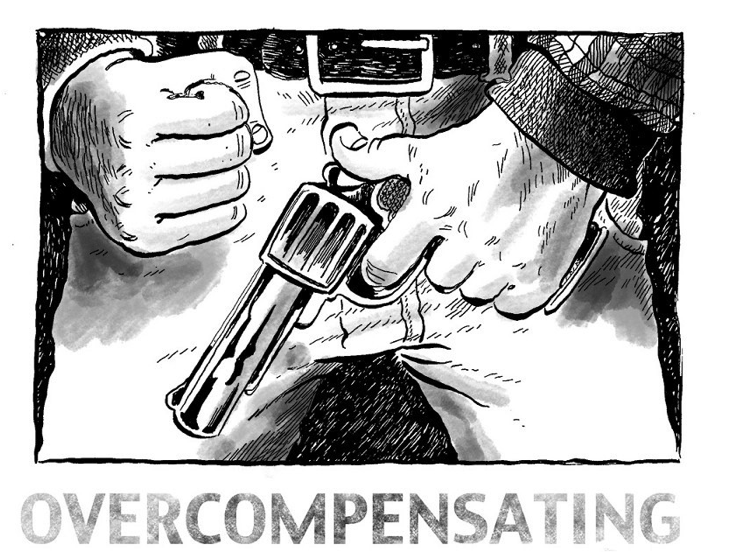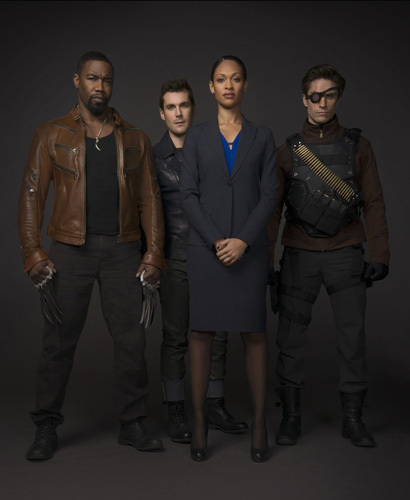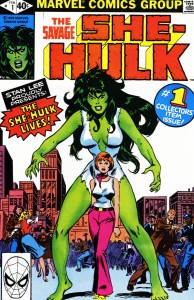Trigger-Warnings: Discussion of domestic violence and abuse, mention of incest and child sexual abuse.
_____________
On December 7, 2014, Mike Dawson published a comic titled “Overcompensating” on The Nib. In it, Dawson creates a character, which, for the purposes of this article, will be called The Narrator. The Narrator tells us he has a “bad breakup” with his partner. The Narrator tells us many times he is a man, male, white, and American. He describes how society has framed his demographic as the protagonist, and because of this he feels entitled. We see images of muscular movie stars. The Narrator seeks revenge against his ex-partner, and has a fight with her new love interest.
The beginning image is the waist of a man holding a gun, and the last image is that same waist without a gun. We can surmise there is a penis in those pants. The comic suggests his masculinity, gun = penis, was at stake throughout this scenario. It also claims to critique this belief.
This comic is about retaliation when The Narrator, a man, feels wronged. It is about controlling his ex-partner, a woman. Yet we never see her. This comic is inherently about women, yet it’s as if women do not exist in this world. The Narrator frames this about himself and his masculinity.
The Narrator wants this comic to be about him and his inadequacies, rather than the woman he is perpetuating violence against.
This is a story about an abusive man.
Breaking up with an abuser can be very hard to do. In fact, leaving a nonabusive partner is generally easier, contrary to what many people believe. Few abusers readily allow themselves to be left. When they feel a partner starting to get stronger, beginning to think for herself more, slipping out from under domination, abusers move to their endgame. Some of their more common maneuvers include:
Threatening or assaulting anyone you try to start a new relationship with, or anyone who is helping you.
Stalking you.
This quotation is taken from Lundy Bancroft’s book, Why Does He Do That?: Inside the Minds of Angry and Controlling Men. Published 2003 by Berkley Books, New York. Bancroft has spent over twenty years specializing in domestic abuse and the abusive behavior of men.
In the 1890s Freud wrote a paper titled “The Aetiology of Hysteria.” Due to the large amount of his female patients revealing childhood incest victimization to him, Freud concluded that child sexual abuse was one of the major causes of emotional disturbances in adult women.
His colleagues criticized this paper. No one could believe that men of excellent reputations, as his female clients were daughters of well-to-do families, could be perpetrators of incest.
Freud recanted his conclusions, thus proposing the Oedipus complex, explained by Bancroft:
According to this theory any young girl actually desires sexual contact with her father, because she wants to compete with her mother to be the most special person in his life. Freud used this construct to conclude that the episodes of incestuous abuse his clients had revealed to him had never taken place; they were simply fantasies of events the women had wished for when they were children and that the women had come to believe were real. This construct started a hundred-year history in the mental health field of blaming victims for the abuse perpetuated on them and outright discrediting of women’s and children’s reports of mistreatment by men.
Once abuse was denied in this way, the stage was set for some psychologists to take the view that any violent or sexually exploitative behaviors that couldn’t be denied – because they were simply too obvious – could be considered mutually caused. Psychological literature is thus full of descriptions of young children who “seduce” adults into sexual encounters and of women whose “provocative” behavior causes men to become violent or sexually assaultive toward them.
There is a long history built into psychology that maintains the elimination of survivors from narratives of abuse.
As Dawson’s Narrator expounds in this comic critiquing male privilege, he ignores the existence of people who are not men. There is no vantage point for a woman or non-binary person to enter this narrative, because they do not exist to him, as with many narratives on abuse since the dawn of the Oedipus complex. He is focusing on himself, his masculinity, and his anger.
In this comic, The Narrator is very angry. “Overcompensating” has no other emotion in it than anger. But anger does not make a man abusive. Bancroft explains:
When people conclude that anger causes abuse, they are confusing cause and effect. [My client] was not abusive because he was angry; he was angry because he was abusive. Abusers carry attitudes that produce fury. It would be futile to teach [my client anger management skills], because his thinking process will soon get him enraged again.
Although our feelings can influence how we act, our choices of how to behave are ultimately determined by our attitudes and our habits.
Abusive men aren’t abusive because of anger; anger is developed because they are abusive. Abusers carry entitled attitudes that make them angry. This entitlement is key to Dawson’s character, and the comic attempts to explain this entitlement through film tropes.
The Narrator fantasizes himself as the hero of his movie. He is big, muscular, in control. However, in the reality of this comic strip, The Narrator is scrawny. The fight he has with his ex-partner’s new love interest is a joke. Contrary to the images of gun toting strong movie stars, the fight scene is drawn in a style that portrays The Narrator and the man he is fighting as childlike.
What does this comic’s climactic fight scene do? Does The Narrator believe he is being self-deprecating? This comic is titled “Overcompensating.” But that’s misguided. The Narrator depicting himself as scrawny is not a self-deprecating joke. It perpetuates the myth that only muscular men can be dangerous. But, as Bancroft says, abusers can be of any demographic, size and shape, and can be just as harmful physically and emotionally. In this comic, Dawson claims that men who do not look like a film star feel the need to “overcompensate.” But Bancroft explains:
My abusive clients sometimes become aware of these ways which society has shaped their values and, sticking closely to their long-standing abusive habits, seize this insight as a new excuse. Instead of saying “I was drunk” or “I was abused as a child,” they rise to a new level of sophistication in escaping responsibility, declaring, “I did it because I learned entitled expectations and the devaluing of females.” I respond by telling the client that he is putting old wine in a new bottle. “The number-one lesson you seem to have learned,” I say, “is how to make excuses for abusing women. And I see that you’re still practicing it.” Abusive men do need to learn about social influences, but not in a way that gives them yet another means of letting themselves off the hook.
Anger is not a reason for abuse. Being socialized a man is not a reason for abuse. The only reason abuse happens is because a person is abusive.
The Narrator is a man who admittedly seeks control over a woman. Is this the only incident of abusive action by The Narrator? We’re never told. But what leads a man to stalking his ex-partner? The feeling of ownership, entitlement, the right to her. This didn’t spring up overnight.
An abuser’s core problem is that he has a distorted sense of right and wrong. This comic presents to its audience this distortion under the guise of self-criticism. The story of self-criticism is seductive, sympathetic. Bancroft explains why abusers create these stories:
You may wonder why, if abusive men feel justified in their actions, they distort their stories so much when seeking support. First, an abuser doesn’t want to have to explain his worst behaviors – his outright cruelty, for example, or his violence – to people who might find those acts distasteful… Second, he may carry some guilt or shame about his worst acts, as most abusers do; his desire to escape those feelings is part of why he looks for validation from other people, which relieves any nagging self-doubt.
Through self-centering The Narrator seeks validation for his actions. But to delve further into Bancroft and specifically why this comic is about The Narrator’s masculinity:
The abuser’s dehumanizing view of his partner as a personal possession can grow even uglier as a relationship draws to a close. I sometimes find it extraordinarily difficult to get a client to remember at this point that his partner is a human being with rights and feelings rather than an offending object to destroy. At worst, his efforts to reestablish his ownership may include following her and monitoring her movements, scaring people who try to assist her, threatening men she is interested in dating, kidnapping the children, and physically attacking her or the people close to her. For abused women separation is a time of particularity high risk of homicide or attempted homicide, which can sometimes involve murderous assaults on her new boyfriend, her children, or on other people she cares about.
To repeat:
I sometimes find it extraordinarily difficult to get a client to remember at this point that his partner is a human being with rights and feelings rather than an offending object to destroy.
This comic is only about The Narrator’s masculinity because he has forgotten his partner is a human being. He has minimized her humanity in this event of his life. She exists as a ghost of his past, but The Narrator still keeps tabs on her to the present day, as said at the end of the comic:
Decades later, that couple is still together. They got married, they have kids. How much time do they spend today concerning themselves with questions of my masculinity? How fortunate is it for all of us the answer is likely, none at all?
The Narrator ends this comic by applauding his ex-partner and her husband for not currently concerning themselves with his masculinity. This again casts the point of view completely on The Narrator and his needs. Of course The Narrator’s emotional needs would never cross their minds! At the time, they were focusing on protecting themselves against a violent stalking man. If they do currently think of him, it wouldn’t be to ponder his masculinity; they would be processing this distressing event. This was a moment of extreme violence in their lives.
The danger within this comic is the creation of excuses for abusive behavior. The Narrator never outwardly admits he was abusive. He gives us statistics on domestic violence, but he never once owns his actions as wrong or violent towards his ex-partner. He gives us events and excuses for them. We are meant to read into the story that his actions were possibly abusive, while at the same time casting doubt upon that assumption. This story is a distortion meant to create empathy, a story developed in his point of view and his point of view alone.
“Overcompensating” develops the point-of-view of an abusive man, asking its audience to empathize with its Narrator under the guise of a critique on masculinity. It’s misguided in its critical approach, effectively eliminating a woman’s humanity. We do not get to know if this is a true case of abuse. And even if he were to tell us, The Narrator would not be the proper source to diagnose a problem. Only his partner can tell us if this is a case of abuse. But we do not even get to see her face.























